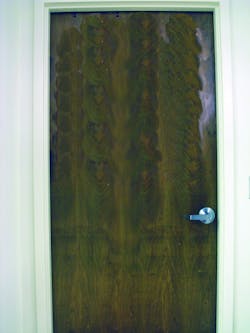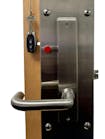With political and social unrest in the United States, locksmiths must think not only how best to protect possessions after a tragedy but also how to help to prevent them from occurring. The Classroom Security Function Leverset is just one choice for being “security proactive” for schools, universities and commercial buildings in general.
PDQ Industries, Inc. Of Leola, Penn., produces the XGT 135, an ANSI F88 Classroom Security function cylindrical leverset. The double cylinder PDQ XGT 135 is designed to maintain a high level of security for the classroom, eliminating the necessity to exit the classroom to lock the outside lever. In case of an emergency, the inside lock cylinder can be used to lock the outside lever. The inside lock cylinder can also be used to unlock the outside lever. This classroom function leverset operates the latch bolt from either the outside or inside lever. The inside lever is always free for egress.
The PDQ XGT Series keyed leversets conform to ANSI/BHMA A156.2-1996, Series 4000, Grade 1. They are U.L./U.L.C. listed for “A” label 3 hour single doors up to 4’0” x 8’0”. The lever options are ADA compliant. According to PDQ, the XGT Series exceeds 3000 in lbs. of torque resistance. The lever styles that have a return to within one-half inch of the door are California Fire Marshal Compliant.
These non-handed cylindrical leversets are manufactured of zinc die cast, investment cast and chromated cold rolled steel. They are designed to accommodate door thickness of 1-3/4” to 2-1/4” standard. The PDQ XGT Series fit standard 161 door prep with a backset of 2-3/4”. Thru bolting is at 12 and 6 o’clock, and located 1-3/8” above and below the centerline of the lock.
The levers are solid die cast zinc with no plastic inserts. Each lever is a minimum 5-1/2” overall length. The lever’s supportive spring power is independent of chassis or latch unit. The roses are 3-3/8” in diameter.
The latchbolt has a 9/16” throw. When unlocked, complete retraction of the latchbolt requires only a 41-degree rotation of a lever.
The standard stainless steel or wrought brass strike plate is 4-7/8” x 1-1/4” (ASA). Optional strike plate sizes include the T-Strike or a Full Lip Strike.
Note: When installing the XGT 135, do not tighten the latch bolt into the edge of the door. Leave the two mounting screws very loose. This will make it easier to install the lock chassis and properly position the retractors.
Installing the PDQ XGT 135 double cylinder cylindrical leverset is different as the chassis is inserted from the interior onto the exterior. Once the chassis is positioned properly, the installation is basically standard except for this double cylinder lock must be properly timed. This ensures that the keyed operation for either lever locks or unlocks the outside lever. The inside lever offers free egress.
Double cylinder leversets can easily be mistimed because the removal and the installation of the lever(s) require the key inserted into the lock and rotated. Improper rotation causes the timing of the lock cylinders to mis-align. The PDQ XGT 135 uses a spring-loaded lever clip to secure both the outside and inside levers onto the lock chassis. They do not use a setscrew.
To properly time the XGT 135:
Step 1. When assembling the leverset, do not install the inside or outside levers.
Step 2. Install the chassis onto the door, securing with the two thru door mounting screws. Note: The outside mounting plate slides onto the thru-bolts using the notched openings not the drilled holes.
Step 3. Install the rose scalp over the inside rose plate.
Step 4. Insert the key into the inside lever and install onto the chassis.
Note: Because the tailpiece is not rigid, it may be necessary to use a thin probe to lift it up to align with the lever slot in the inside key spindle.
Verify the inside lever is secured to the lock chassis and the lever clip is fully extended. Make sure the lever will not pull off.
Step 5. Remove the key.
Step 6. Rotate the key spindle within the outside rose spindle counterclockwise to the stop position.
Step 7. Rotate the key spindle clockwise to the horizontal position. The spindle should only need to be rotates a few degrees.
Step 8. Insert the key partially into the outside lever lock cylinder.
Step 9. Slide the lever onto the spindle and have the tailpiece begin to slide into the lever slot.
Note: Because the tailpiece is not rigid, it may be necessary to use a thin probe to lift it up to the lever slot in the outside key spindle.
Step 10. Insert the key completely and rotate 45 degrees clockwise. The spindle must turn with the tailpiece.
Step 11. Push the outside lever onto the spindle.
Verify the outside lever is secured to the lock chassis and the lever clip is fully extended. Make sure the lever will not pull off.
Step 12. Remove the key from the outside lever. The outside lever should be unlocked and when rotated, retract the latch.
Step 13. Insert the key into the outside lever. Rotate the key one full revolution clockwise. The outside lever should be rigid.
Step 14. Remove the key and insert it into the inside lever.
Note: The key should not be able to rotate clockwise.
Step 15. Rotate the key one full revolution counterclockwise and remove the key. The outside lever should rotate. Rotating the key one full revolution clockwise locks the outside lever.
The PDQ XGT Series leversets are available with lock cylinders equipped with conventional keyways of most major lock manufacturers. These lock cylinders are six-pin tumbler brass cylinders keyed to five. In addition, they are available with the six- or seven-pin tumbler Figure “8”interchangeable core configuration.
The PDQ XGT 135 lever locks are assembled in the U. S. A. with U. S. and foreign materials. The locks meet the requirements of the Buy American Act.
For more information, contact your local locksmith wholesaler or PDQ Industries, 2754 Creek Hill Road, Leola, PA 17540. Telephone: 717-656-4281. Fax: 717-656-6892. Help line: 800-441-9692. Web Site: www.pdqlocks.com.






